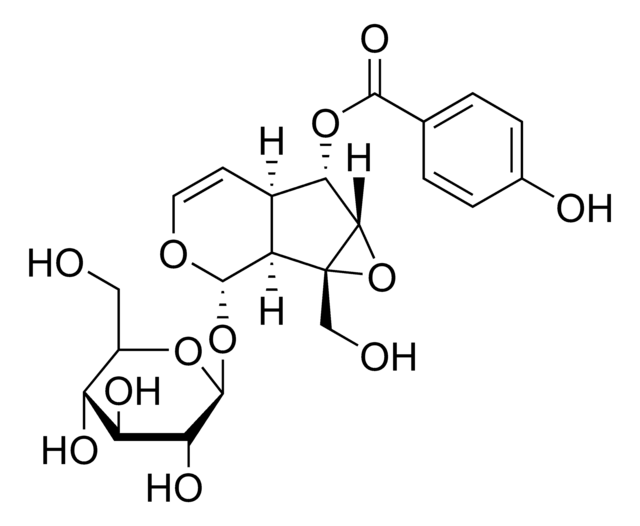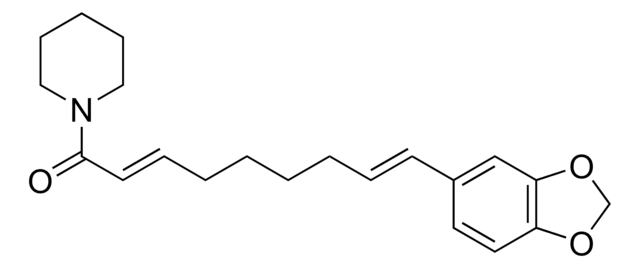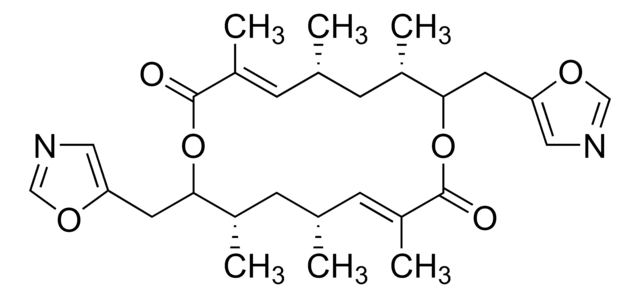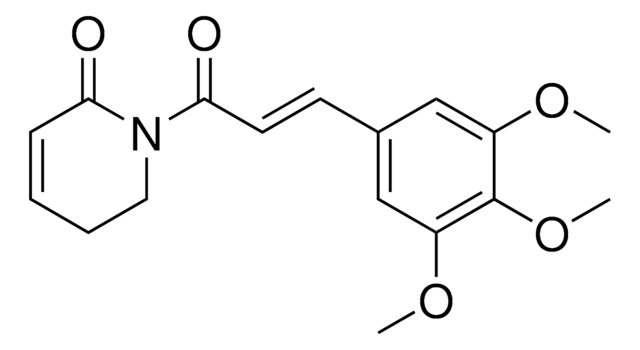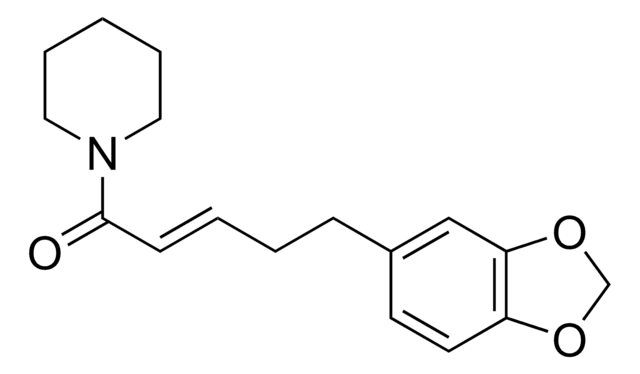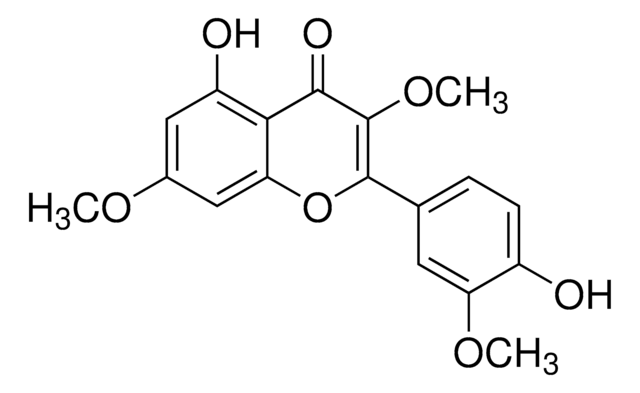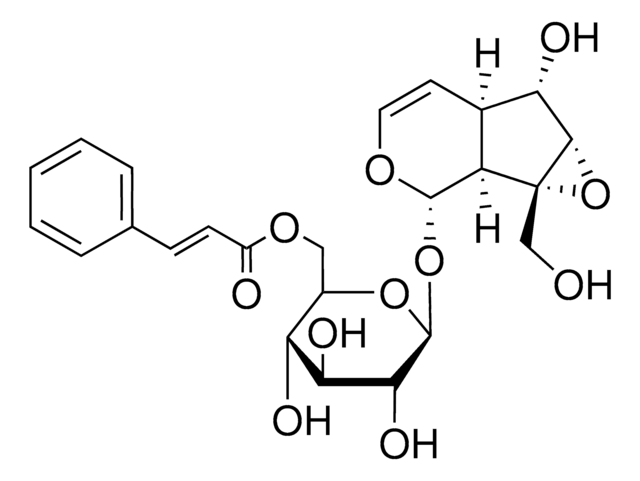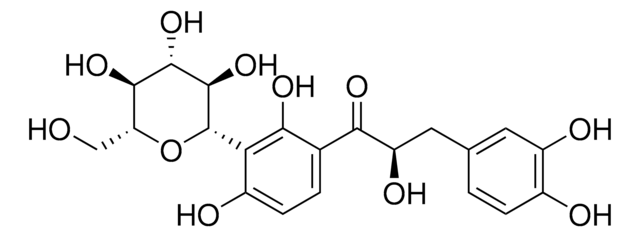SMB01055
Colladin
≥90% (LC/MS-ELSD)
Sinónimos:
Coladin
Iniciar sesiónpara Ver la Fijación de precios por contrato y de la organización
About This Item
Fórmula empírica (notación de Hill):
C26H32O5
Número de CAS:
Peso molecular:
424.53
Código UNSPSC:
12352205
NACRES:
NA.25
Productos recomendados
origen biológico
plant
Análisis
≥90% (LC/MS-ELSD)
formulario
solid
mol peso
424.53
solubilidad
water: slightly soluble
aplicaciones
metabolomics
vitamins, nutraceuticals, and natural products
temp. de almacenamiento
−20°C
Categorías relacionadas
Descripción general
Colladin, a sesquiterpenoid coumarin, is a natural product commonly available from Ferula Sp. (F. arrigonii, F. vesceritensis, F. campestris and F. sinaica) plants. Existing research suggests that this plant-derived metabolite exerts various biological activities, including anticancer, neuroprotective, and antiglaucoma properties.
Aplicación
It is a natural product derived from plant source that finds application in compound screening libraries, metabolomics, phytochemical, and pharmaceutical research.
Acciones bioquímicas o fisiológicas
According to the existing research, Coladin exhibited notable anti-cancer properties by substantially reducing cell proliferation and mitochondrial dehydrogenase activity in mouse B16F1 melanoma cells. These effects induced apoptosis through mechanisms involving decreased mitochondrial membrane potential and mitochondrial respiratory rate, underscoring its potential as a natural anti-cancer agent. Isolated from the roots of Ferulago campestris, coladin, along with other compounds such as umbelliprenin and epielmanticine, displayed inhibitory activity against Acetylcholinesterase (AChE) with an IC50 of 0.1 mM, suggesting its potential application in the treatment of neurological disorders like Alzheimer′s disease. Coladin, identified as one of the constituents in Heptaptera triquetra fruit, exhibited remarkable inhibitory activity against acetylcholinesterase (AChE), human carbonic anhydrase isoenzyme (hCA) I, and hCA II, with IC50 values of 8.25 nM, 28.90 nM, and 43.31 nM, respectively. This highlights its potential in the development of phytotherapeutics for conditions like Alzheimer′s disease (AD) and glaucoma.
Características y beneficios
- High quality compound suitable for multiple research applications
- Compatible with HPLC and mass spectrometry techniques
Otras notas
For additional information on our range of Biochemicals, please complete this form.
Código de clase de almacenamiento
11 - Combustible Solids
Clase de riesgo para el agua (WGK)
WGK 3
Punto de inflamabilidad (°F)
Not applicable
Punto de inflamabilidad (°C)
Not applicable
Certificados de análisis (COA)
Busque Certificados de análisis (COA) introduciendo el número de lote del producto. Los números de lote se encuentran en la etiqueta del producto después de las palabras «Lot» o «Batch»
¿Ya tiene este producto?
Encuentre la documentación para los productos que ha comprado recientemente en la Biblioteca de documentos.
Sesquiterpene esters and sesquiterpene coumarin ethers from Ferula linkii-TF
Gonzalez A G, et al.
Phytochemistry, 33(4), 863-866 (1993)
Phytochemical content and enzyme inhibitory effect of Heptaptera triquetra (Vent.) Tutin fruit against acetylcholinesterase and carbonic anhydrase I and II isoenzymes
Kaya AC, et al.
Chemical Papers, 77, 5829?5837-5829?5837 (2023)
Cytotoxicity of sesquiterpenes ferulenol and coladin on liver FAO and B16F1 melanoma cells
Boulmeltout M, et al.
Pharmacognosy magazine, 14, 333-337 (2018)
Identification of non-alkaloid acetylcholinesterase inhibitors from Ferulago campestris (Besser) Grecescu (Apiaceae)
Dall'Acqua S, et al.
Fitoterapia, 81, 1208-1212 (2010)
Nuestro equipo de científicos tiene experiencia en todas las áreas de investigación: Ciencias de la vida, Ciencia de los materiales, Síntesis química, Cromatografía, Analítica y muchas otras.
Póngase en contacto con el Servicio técnico